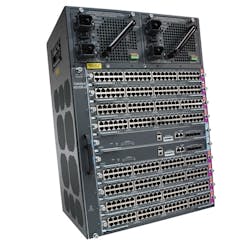Cisco has been a leader in the application of IEEE 802.3. Its term for the latest pushes into higher power is “UPOE,” or “Universal Power over Ethernet.” The company’s vision of the technology embraces not just the evolution of thin clients, but financial trading floors, hospitality, and retail establishments.
This file type includes high resolution graphics and schematics when applicable.
On the financial trading floor, for example, Cisco says it’s responding to today’s traders demands for multiple screens, live video feeds, and conference calls, all serviced at the kinds of speeds necessary to keep up with the various exchanges around the world. “All of these request high availability, multicast, and buffering architecture as the key features for the network.”
Powered hardware includes “IP turrets,” or “trading turrets,” that help traders manage incoming and outgoing call activity with customers or counter-parties via arrays of dedicated point-to-point telephone lines (Fig. 1).
Previously, IP turrets have been powered by wall power with backup UPS. Now, for cost and efficiency the trend is powering via UPOE technology (of course, this transfers the reliability burden to the switch).
Most recently, the company introduced the Catalyst 4500E switch, which provides line-rate unicast and multicast switching with consistent low latency to all user access ports, along with full hardware redundancy and in-service software upgrades (Fig. 2). Other compatible Cisco switches include the compact 3560C and 2960C.
About the Author

Don Tuite
Don Tuite (retired) writes about Analog and Power issues for Electronic Design’s magazine and website. He has a BSEE and an M.S in Technical Communication, and has worked for companies in aerospace, broadcasting, test equipment, semiconductors, publishing, and media relations, focusing on developing insights that link technology, business, and communications. Don is also a ham radio operator (NR7X), private pilot, and motorcycle rider, and he’s not half bad on the 5-string banjo.



